| Elektronika MK-61/52
|
 |
 |
 |
 |
 |
 |
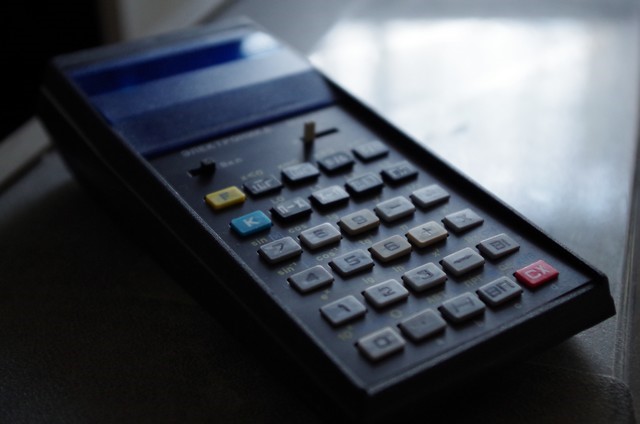
| Specifications | MK-Compiler | Calculators 3000 | Enhanced MK-52 | ROM Module BRP-3 (Maths) | ROM Module BRP-4 (Games) | Speed testings |
RPN Calculator with

|
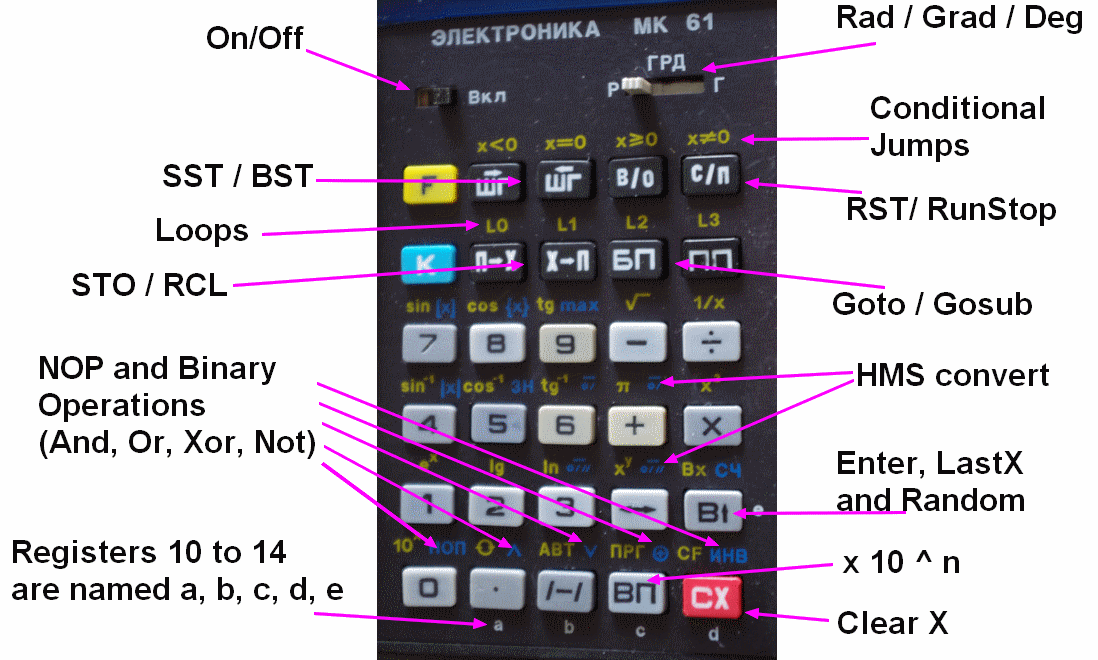 |
| Forensic On scientific functions, calculate in degrees: arcsin(arccos(arctan(tan(cos(sin(9))))))Result: 9.0881454. The exact value is 9 ! |
Hebdogiciel20 =0 =1 2 FOR 0 SQR NEXT FOR 1 X^2 NEXT STOPResult: 1.6889469 The exact value is 2 ! |
I wrote a little compiler for Windows that :
NEW : recreate a source file from a C3 program file. NEW : recreate a source file from a serie of hex codes. |
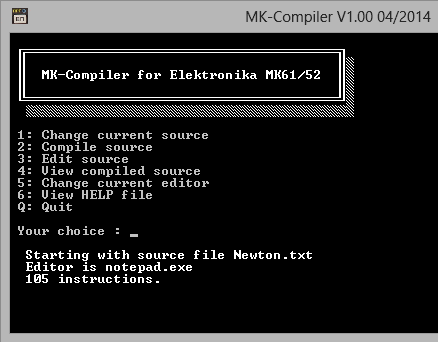 |
; NEWTON method for equations ; solves f(x)=0 ; function is programmed at label f(x), it receives x on the stack ; it can use the whole stack and registers 4-9 and b-d ; set precision into register "e" (0.01 for example) ; in the X register, put a first guess of the solution and RUN. ; it returns the solution. ; you can start again with new parameters (precision or starting x) ; usage: store error in register e (example 0.01 STO e) ; go to first step ( B/0) ; key in the first x value and RUN. #c3 1 ; auto save to C3 file #reg e error #reg a x #reg 0 delta #reg 1 h #reg 2 fxh #reg 3 fx DO =x $1e-4 =delta REPEAT @x @delta * IF(x=0)THEN @delta ENDIF =h ; h=0.0001x or 0.0001 if x=0 @x + GOSUB f(x) =fxh ; calculates f(x+h) @x GOSUB f(x) =fx ; calculates f(x) @h * @fx @ fxh - / ; calculates dx = hf(x)/(f(x)-f(x+h)) = -f(x)/f'(x) ENTER sum x ; new x = x + dx x<>y abs @error - ; abs(dx) - error UNTIL(x<0) ; stop if <0 (if abs(dx) < error) @x ; display x STOP LOOP f(x): RTN |
Step | Code | Keys ------------------------ 000 | 4A | STO a 001 | 01 | 1 002 | 0C | EE 003 | 04 | 4 004 | 0B | /-/ 005 | 40 | STO 0 006 | 6A | RCL a 007 | 60 | RCL 0 008 | 12 | * 009 | 5E | F X=0 010 | 12 | 1 2 011 | 60 | RCL 0 012 | 41 | STO 1 013 | 6A | RCL a 014 | 10 | + 015 | 53 | GOSUB 016 | 42 | 4 2 017 | 42 | STO 2 018 | 6A | RCL a 019 | 53 | GOSUB 020 | 42 | 4 2 021 | 43 | STO 3 022 | 61 | RCL 1 023 | 12 | * 024 | 63 | RCL 3 025 | 62 | RCL 2 026 | 11 | - 027 | 13 | / 028 | 0E | ENTER 029 | 6A | RCL a 030 | 10 | + 031 | 4A | STO a 032 | 14 | X<>Y 033 | 31 | K ABS 034 | 6E | RCL e 035 | 11 | - 036 | 5C | F X<0 037 | 06 | 0 6 038 | 6A | RCL a 039 | 50 | STOP 040 | 51 | GOTO 041 | 00 | 0 0 042 | 52 | RTN ------------------------ Addr | Name ------------------------ 042 | F(X) ------------------------ Reg | Name ------------------------ 0 | DELTA 1 | H 2 | FXH 3 | FX a | X e | ERROR ------------------------ |
|
Eugene Troitskiy is the author of the great Calculators 3000.
This emulator gives you access to a large field of russian calculators (20 of them!). Among them, the MK-61 and the enhanced MK-52.
When compiling a program, you can use the #C3 directive to get a C3 file loadable by Calculators 3000. You just have to load it with the option "Open with current calculator". 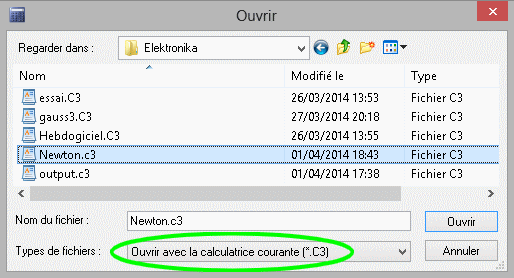
MK-Compiler generates a C3 file that looks like this: group Document end MachineFileName = "MK61.cfg" group Machine group ProgramMemory Size = 105 Data = 4A010C040B406A60125E1260416A105342426A5342436112636211130E 6A104A14316E115C066A505100520000000000000000000000000000000000000 00000000000000000000000000000000000000000000000000000000000000000 0000000000000000000000 end end |
 |
It is an enhanced model, similar to the MK-61, but with the following:
Read this highly detailed article about the Eprom usage, a big thank to Alexandre Dumont for translating from russian to english ! |

|
| The factorial example: | Compiled file: | Clearing memory: | Saving: | Loading: |
|---|---|---|---|---|
#reg 0 n
DO
=n
1
FOR n
@n *
NEXT
STOP
LOOP |
Step | Code | Keys ------------------------ 000 | 40 | STO 0 001 | 01 | 1 002 | 60 | RCL 0 003 | 12 | * 004 | 5D | F L0 005 | 02 | 0 2 006 | 50 | STOP 007 | 51 | GOTO 008 | 00 | 0 0 ------------------------ Reg | Name ------------------------ 0 | N ------------------------ |
The program uses 9 steps, so you have to prepare 9 free bytes in the EEPROM, let's say from address zero. To do that,
put the switch on CLEAR.1000009 A↑ ↑↓ The address is defined this way: 1ssssbb with
|
Then, you key in the program! Don't do it before as the CLEAR function erases both EEPROM and RAM ! Once it is entered, to save it, put the switches on SAVE and on PROGRAM and: 1000009 A↑ ↑↓ Once again, your program has desappeared, the SAVE function clears the RAM... |
To get your program back into RAM, even after a power off, put the switch on LOAD(*),
the other being on PROGRAM, and:
1000009 A↑ ↑↓ This time, it came back to RAM ! |
1001820 A↑ ↑↓Explanations: 9 bytes occupied are 18 nibbles (half-bytes!), and then, from that 18th nibble, you want to use 20 bytes.
This is a module containing 60 maths programs that you plug into the MK-52. Among them, you'll find:
Download french manual for ROM Module BRP-3 |
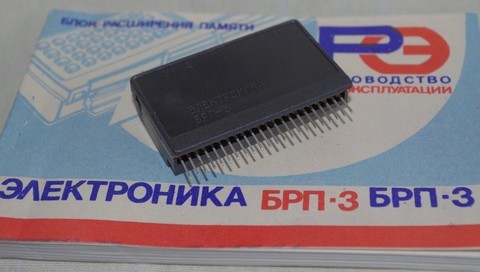 |
| Simultaneous equations | Entering data | Results |
|---|---|---|
The program 5 of bank 1 solves this system:
a.x + b.y = c a'.x + b'.y = c'Switch the module ON, set bank to 1, switches in position LOAD and PROGRAM, then type: 1047635 A↑ ↑↓This address comes from the user's manual, the program is now ready in RAM. |
Enter the data into the registers:
|
Put the program pointer to zero with в/О and run it with
С/П. Upon return, the display gives you the y value, with ↔ you get the x value (also in registers 1 and 2), the determinant is in register 3. If the display tells you ЕГГОГ, then the determinant is nul and no unique solution can be found. |
This is a ROM module containing 54 programs that you can plug into the MK-52. Among them, you'll find:
Download french manual for ROM Module BRP-4 |
 |
In this game you must align three points using this diagram :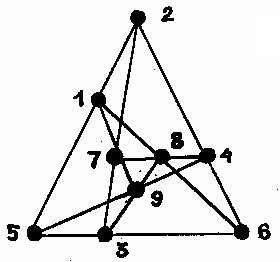
|
Switch the module ON, select bank 2, switches in positions LOAD and PROGRAM, then type:
1176498 A↑ ↑↓The address comes from the manual, now you can use the program. Initialize it with 77 into register Rd and run it with в/О then С/П |
The games returns the first position taken by the computer: it takes the 1!
Now, I type the position I want, let's say 8, and then С/П. The game goes on this way. If 77 is displayed, the computer has won and typing ↔ you'll see its last position taken. |
| The program | Results | Conclusion |
|---|---|---|
STEP KEY n + n+1 GOTO n+2 nThe stack contains 1-1-1-0, so the program counts one by one starting from zero. The program is run during 60 seconds, then stopped and I just have to read the current counter value. The test has been performed at steps 0, 8, 16 etc... |
 |
The MK-61 is 15% faster than the MK-52. The step number has a significant influence on the excution speed. When at step 100, the speed is only 73% compared to the one at step zero. Step from 0 to 31 give the maximal speed. |
| The program | Results | Conclusion |
|---|---|---|
Prog i Prog reference STEP KEY STEP KEY 00 RCL i 00 NOP 01 STO i 01 NOP 02 L3 02 L3 03 00 03 00 04 STOP 04 STOPRegister i contains PI, register 3 contains 50 for a loop 1-50. I wrote a reference program replacing RCL/STO with two NOP (no-operation). The execution times are the differences between the two versions. The test has been performed using registers i=0, 4, 8, 12. |
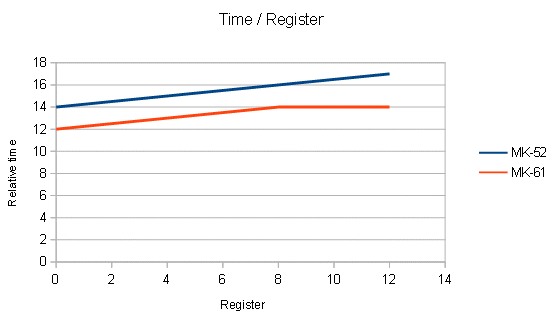 |
Even if differences are not spectacular, the lower, the faster! |